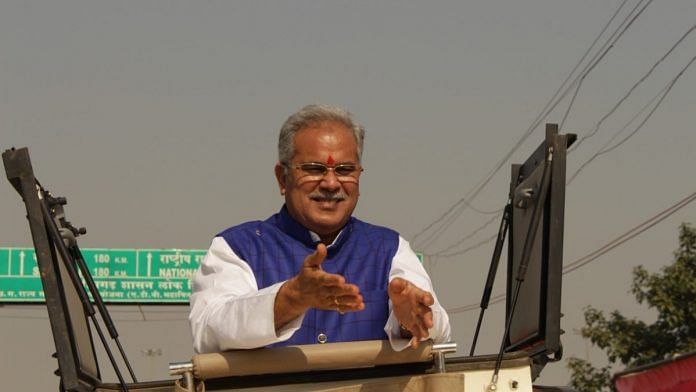Raipur: Chhattisgarh is set to become the second Indian state to allow its tribal population to manage and exploit forest produce at a community level under the Forest Rights Act, 2006.
According to a statement by the Bhupesh Baghel government, tribals in the state will be given rights of forest land ownership and exploitation of resources under the Community Forest Resources Rights (CFRR) provisions of the Act.
The forest rights activists in Chhattisgarh have welcomed the state government’s decision offering CFRR to forest dwellers, but with caution, saying it has to be seen if the government has the will to implement its decision.
So far, the management and exploitation of these resources was done by the state forest department.
The new rights will be granted at the gram sabha level and not at an individual level.
The state tribal affairs department will serve as nodal agency for the CFRR provision, and the forest department will function as facilitator, said a senior state forest department official.
Forest officials in the state have called the extension of these rights to the tribals a “historic” move.
The tribal make up close to 32 per cent of Chhattisgarh’s 3.2 crore population.
Forest Minister Mohammed Akbar said the state forest department will soon begin infrastructure creation to help in implementing the decision.
Maharashtra was the first state to allow community forest rights under the 2006 Act.
Also read: Chhattisgarh launches Nyay, will transfer Rs 10,000 per acre to bank accounts of farmers
What officials say about the move
According to senior forest department officials, so far the tribal population in Chhattisgarh was forced to limit its economic activities to gathering of non-timber forest products or minor forest produce, and was at the mercy of local forest officials. It had no rights over sale of timber products, which was completely managed by the state forest department.
The Bhupesh Baghel government’s new decision will enable tribals and other traditional forest dwellers to have rights over sale of timber products as well, said the officials.
“Forest department will function as a facilitator for implementation of the government’s decision to allow forest dwellers and villagers to manage forests and exploit resources to strengthen their economy. This will be done according to the provisions of Community Forest Resources Rights of the Act,” said Chhattisgarh Principal Chief Conservator of Forest Rakesh Chaturvedi.
Speaking about the process, Chaturvedi said, “As per government’s plan and the provision of the act one or more gram sabhas could come forward to stake their claims for CFRR within their respective territories. Forest rights committees of these gram sabhas will have to inform their counterparts in adjoining areas to finalise territorial boundaries amicably.
“Following this gram sabhas will have to meet and hammer out the procedure for mapping their territories with the help of the forest department as the latter has the logistic details of every forest cover in the state,” he said.
The Forest Rights Act is almost forgotten by all the governments including the central government as it speaks about complete control of forest areas by the tribals and other forest dwellers, said another senior forest official who didn’t wish to be named.
“This is indeed a historic beginning in the state towards offering forest dwellers their rights in accordance with the provisions of Forest Rights Act 2006. So far, it has remained dormant. Though one state government had implemented CFRR provisions but it had its limitations,” state wildlife chief Arun Kumar Pandey said.
“In Chhattisgarh, it’s a big move to offer ownership rights of forests to the tribal community and strengthen their economy,” he said.
Also read: Swarms of locusts enter Chhattisgarh forest area from Madhya Pradesh
Forest rights activists welcome the plan, but with caution
Forest rights activists in Chhattisgarh have welcomed the state government’s decision offering CFRR to forest dwellers, but with caution. Speaking to ThePrint, the convenor of the Nadi Ghati Morcha Convenor Gautam Bandopadhya said, “It’s welcomed but has to be seen if the state government has the will to implement its decision as per the intentions of the Forest Rights Act 2006.”
“For now it can be simply said that the government has honoured the democratic provision of the act by maintaining that the Tribal welfare department will remain a nodal agency. Earlier it was learnt that the government was trying to replace the forest department as nodal agency for delegating CFRR, which was condemnable,” Bandopadhya said.
Badopadhyay added that widespread consultation is needed among tribal population, villagers, government departments and experts to finalise the measures for implementation of the plan.
“There must be a proper scientific convergence of stake holding departments, target groups and experts to finalise the implementation of the action plan. On top of this, the state level monitoring committee constituted under the Forest Rights Act 2006 must also be revived as presently it’s virtually functionless,” added the morcha convenor.
What is Forest Rights Act 2006?
The Scheduled Tribes and Other Traditional Forest Dwellers (Recognition of Forest Rights) Act enacted by the UPA government on 29 December 2006 recognises and vests the forest rights and occupation in forest land to the “Scheduled Tribes and other traditional forest dwellers who have been residing in such forests for generations but their rights could not be recorded”.
Better known as the Forest Right Act, the law outlines multiple rights for the forest dwellers at an individual or community level. These mainly include the rights to hold land and live in the forest under individual or common occupation, or for self-cultivation for livelihood, and the rights of ownership, access to collect, use, and dispose of minor forest produce which has been traditionally collected within or without village boundaries.
Other provisions allow for rights of settlement and conversion of all forest villages into revenue villages, and the rights to protect, regenerate, conserve and manage community forest resources.
Also read: First day of Unlock 1.0 – Delhi shuts its border, street food vendors back in Chhattisgarh



